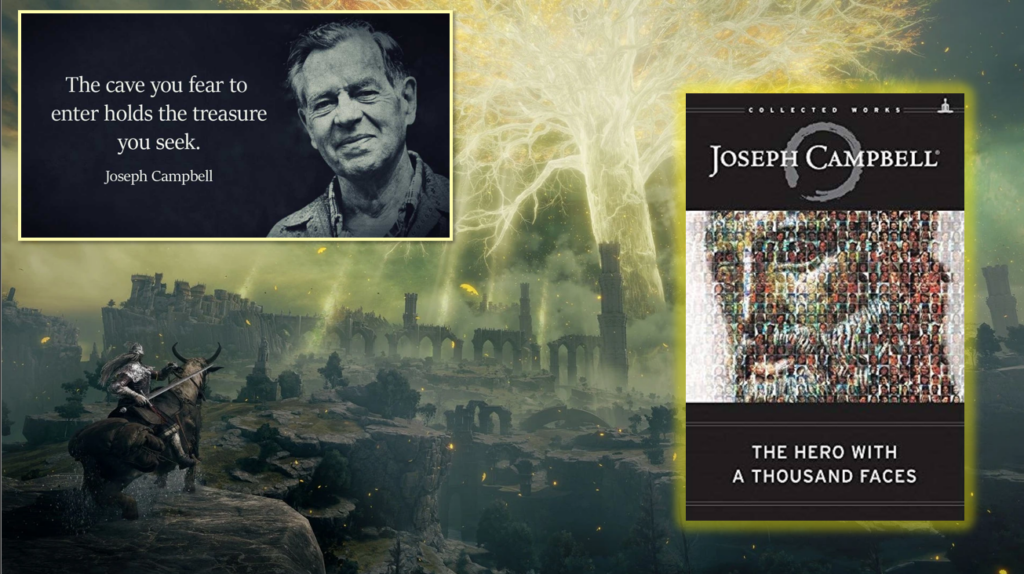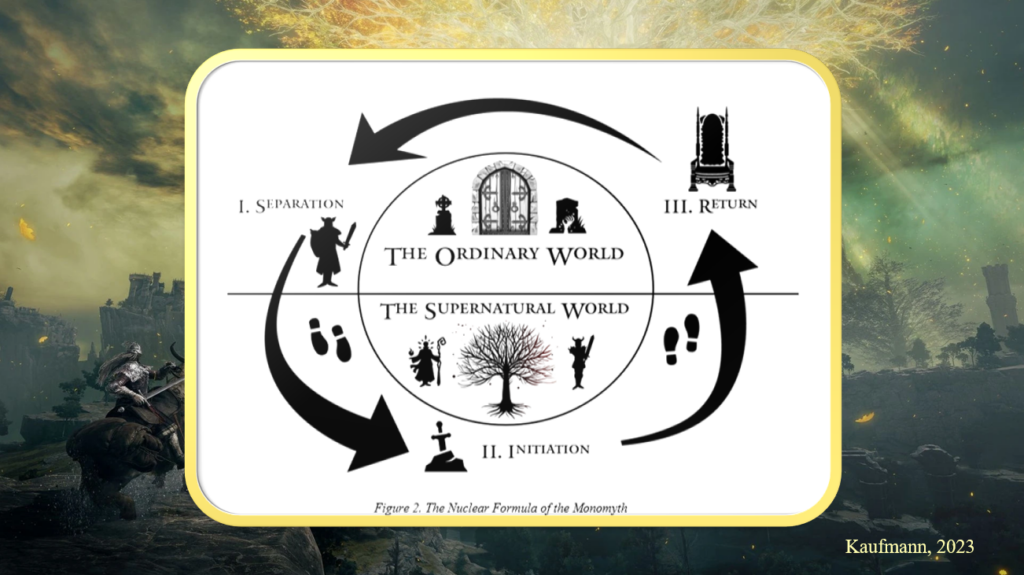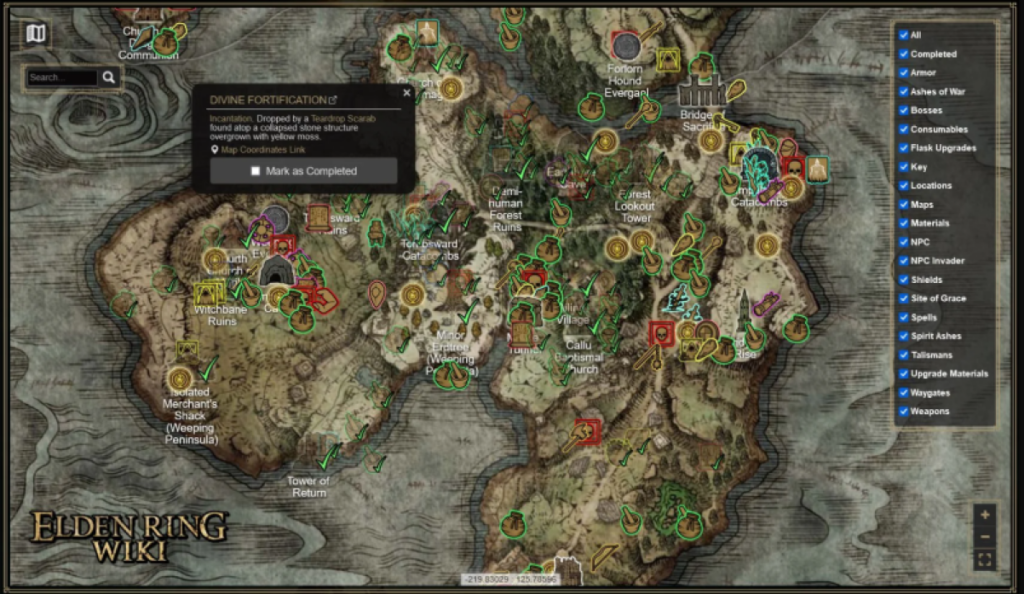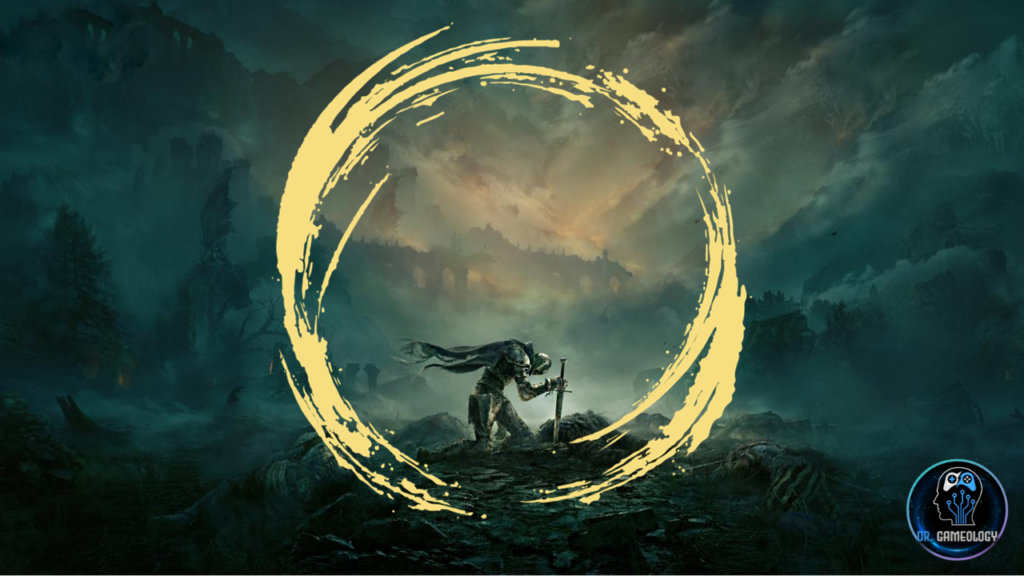For More Geek Therapy for Gamers Videos, Subscribe, Like, & Share Today
Playing the Hero's Journey in Elden Ring
In the realm of gaming, Elden Ring has emerged as a potent symbol of the intertwining of personal growth and gaming experiences. Now let’s shed light on the profound connection between playing the Hero’s Journey in Elden Ring and mental resilience. At first glance, Elden Ring may just be another challenging action role-playing game, but dig deeper and you’ll find it’s a canvas for players to project, confront, and overcome their inner demons, effectively becoming a tool for fostering mental resilience. The game’s demanding landscape, relentless enemies, and cryptic narrative serve to push players beyond their comfort zones, testing and strengthening their resolve in the face of adversity. The journey of the Tarnished, the player’s avatar in Elden Ring, mirrors our struggles in life, echoing the message that victory is sweeter when it’s hard-earned. Stay with us as we delve into the psychological underpinnings of Elden Ring and its potent impact on players’ mental resilience.
Finding Lore to Construct the Journey
In Elden Ring, the game’s lore offers a rich tapestry of narratives that weave a complex world, teeming with mystery and intrigue. The lore of Elden Ring, often cryptic and obscured, challenges players to piece together the game’s vast history and mythology from fragments of information scattered throughout the Lands Between. This lore is not only the backbone of the game’s narrative but also its diverse and memorable characters, formidable enemies, and enigmatic locations, all contributing to the immersive experience. The game’s deep and intricate lore fosters an engrossing environment that keeps players captivated and eager to explore, learn, and conquer. In the following segments, we will delve into the intricacies of Elden Ring’s lore, exploring its significance and how it shapes the player’s journey.
Elden Ring leverages minimal dialogues interspersed with world exploration to deliver its story, a unique brand of storytelling that adds intrigue to the player’s journey. With fewer dialogues, the game compels players to explore the expansive landscapes, encouraging investigation and interpretation of the environment to understand the plot. This exploration-based narrative style allows players to unearth the story at their own pace, making each discovery feel rewarding and personal. From deciphering cryptic messages inscribed on ancient ruins, to confronting and interpreting the silent yet expressive body language of non-player characters, the player becomes an active protagonist in unveiling the story. This method of storytelling enhances the intrigue, making the narrative of Elden Ring a puzzle that the player solves by engaging with the world and its minimalistic dialogues.
Elden Ring’s challenging and meditative journey resonates profoundly with our individual quests through life. We are often confronted with insurmountable obstacles, much like the relentless enemies and cryptic landscapes in Elden Ring. These challenges can feel daunting and sometimes, even impossible to overcome. But, just as in the game, it is our persistence, resilience, and willingness to learn from failure that eventually lead us towards our goals. Elden Ring’s punishing difficulty thus becomes a metaphor for life’s trials, encouraging us to thrive in the face of adversity. We grow stronger with each setback, building our resilience and evolving in our journey, a testament to our enduring spirit. In this way, playing Elden Ring becomes more than just a pastime. It becomes a personal journey of growth and self-discovery, echoing the undying human spirit to persevere and triumph over life’s adversities.
Exploring the Monomyth and Its Influence on Elden Ring

The Monomyth, also known as the Hero’s Journey, is a narrative structure that traces its roots back to the work of noted scholar Joseph Campbell. In his seminal work “The Hero with a Thousand Faces”, Campbell outlined a recurring pattern in stories from diverse cultures and periods of history. This pattern, the Monomyth, typically features three phases: Departure, Initiation, and Return. In the Departure stage, the hero is called to an adventure, often leaving the familiar world behind. The Initiation stage sees the hero face various trials and obstacles, progressively gaining wisdom, skills, and often, an important artifact or knowledge. Finally, in the Return stage, the hero comes back to their ordinary world, transformed and bearing gifts, either tangible or intangible, that often benefit others. This universal template has had a profound influence on storytelling, influencing a myriad of authors and filmmakers, and as we will discuss shortly, game developers like those behind Elden Ring.
The Hero’s Journey in Elden Ring plays an integral role in driving player engagement. By structuring the game narrative around this universal pattern, developers create a profoundly relatable and immersive journey that resonates with players on a deep, psychological level. The familiar stages of Departure, Initiation, and Return mirror the personal growth and self-discovery that players experience within the game. As they navigate challenges and adversities, much like the hero in the Monomyth, players develop resilience and problem-solving skills, fostering a sense of accomplishment and empowerment. This connection between the Monomyth and player engagement effectively transforms the gaming experience into a deeply personal and emotionally enriching journey.
Elden Ring’s vast and intricate map is punctuated by a myriad of boss encounters, each presenting a unique challenge requiring strategic thought and skillful execution. These boss fights, often intimidating and brutal, serve as milestones in the player’s journey. They test the skills learned and honed through exploration of the expansive map, pushing players to adapt and overcome. The diverse environments within the map, from crumbling ruins to lush landscapes, hide clues and lore that can give insightful strategies for these encounters. Such a design ensures that exploration isn’t just a leisurely activity, but a critical part of the player’s progression. The amalgamation of exploration and combat in Elden Ring brilliantly illustrates the game’s core design philosophy, emphasizing the player’s immersion, adaptability, and constant learning.
Just as the interpretation of the Monomyth is an integral part of understanding the story structure and progression in Elden Ring, so too is the interpretation of the game’s mechanics and gameplay elements. These mechanisms—ranging from combat systems to character progression—are not merely tools for player progression but also serve as narrative devices that further enrich and contextualize the story. For example, the unique mechanic of character death and resurrection offers not only a gameplay challenge but also serves as a metaphor for personal growth and resilience, aligning with the themes of the Monomyth. The gameplay elements, much like the narrative, are designed to prompt players to experiment, adapt, and learn, further enhancing the connection between the player’s journey and the Hero’s Journey depicted in the game. This duality of gameplay and narrative interpretation ensures that every element within Elden Ring contributes to the player’s immersion and the game’s rich, layered story, creating a truly holistic gaming experience.
Finding Yourself in the Danger of Combat
The combat system in Elden Ring is a vital component that aids in fostering a sense of confidence and learning through a process of trial and error, and experimentation. With each encounter, the player is encouraged to explore and understand the unique behaviors and attack patterns of their adversaries, a process that may entail numerous failed attempts. Yet, it is through these failures that learning occurs, and with each defeat comes increased knowledge and refined strategy. The game rewards those who persevere, who adapt their tactics, and who aren’t afraid to experiment with different approaches. Over time, the player transforms from a novice to an adept warrior, capable of overcoming even the most formidable foes. This growth is not just represented in statistical improvements, but palpable in the increased confidence and mastery of the player, reflecting the heart of Elden Ring’s design philosophy: the celebration of learning, resilience, and the triumph over adversity.
Elden Ring’s complex combat system encourages not just a physical but a psychological exploration. Each battle serves as a mirror into the player’s psyche, revealing traits of patience, adaptability, and resilience. With every failed attempt and subsequent retry, players uncover layers of their determination and tenacity, fueling personal growth that parallels their character’s progression within the game. Foes in Elden Ring aren’t just physical obstacles to overcome; they represent personal fears, insecurities, and challenges that players confront and surmount. This intimate interplay between combat and psychological exploration redefines the gaming experience, transforming it from a simple pastime into a profound journey of self-discovery.
The dynamic interplay of bravery and fear underpins the Hero’s Journey in Elden Ring. In the face of seemingly insurmountable foes and brutal mechanics, fear is an initial, inevitable response. This fear can manifest as hesitation, second-guessing, and even avoidance of specific challenges within the game. However, it is this very fear that serves as the catalyst for bravery. Each bout of fear confronted and surmounted fosters bravery within the player, pushing them to confront their trepidations head-on and persevere in the face of adversity. This transformation from fear to bravery is mirrored in the player’s growing confidence as they navigate through Elden Ring. As players overcome their fears, they develop faith in their abilities, evolving from wary explorers to confident warriors. Thus, in Elden Ring, fear is not the antithesis of bravery, but rather its progenitor.
The Heroic Journey Using Open World Exploration

The heroic journey and open-world exploration are deeply intertwined in Elden Ring, creating an engaging and immersive gameplay experience. The game’s open-world exploration encourages players to forge their own path, allowing the Hero’s Journey in Elden Ring to emphasize self-determination and discovery. As players traverse the vast landscape, encountering diverse landscapes and formidable foes, they engage in their own heroic journey, meeting challenges and overcoming obstacles much like the protagonists of traditional myths. Each victory, regardless of its scale, marks a step forward in their personal story, reinforcing the idea that the journey matters just as much as the destination. In this way, Elden Ring masterfully combines the allure of open-world exploration with the narrative depth of the Hero’s Journey, offering players a gaming experience that is both challenging and emotionally resonant.
In Elden Ring, the use of Runes and Stat building offer another layer of player growth and transformation. Runes, the in-game currency, are used to enhance a player’s abilities and stats, allowing for the customization and development of the player’s character to suit their preferred playstyle. As players navigate the world of Elden Ring, they accumulate runes and must make strategic decisions on how to allocate these resources, effectively shaping their character’s growth and evolution. The decisions, whether to emphasize strength for melee combat, dexterity for agile maneuvers, or intelligence for magical abilities, are not just mechanical choices but also reflect the player’s personal journey of becoming their version of the hero. As such, rune use and stat building become integral elements of the player’s transformative journey, highlighting Elden Ring’s commitment to intertwining gameplay and personal growth.
Confronting personal demons is another aspect of gameplay that Elden Ring masterfully integrates into the player’s journey. In the game, personal demons aren’t just metaphorical; they manifest as formidable adversaries, puzzles, or intimidating environments. This aspect pushes players to confront the psychological aspects of their fears, hesitation, and self-doubt. Every conquered adversary, solved puzzle, or traversed environment symbolizes an internal battle won, a personal demon vanquished. This integral part of gameplay resonates deeply with players, as they witness their avatar overcoming challenges that mirror their personal struggles. Thus, Elden Ring transforms gameplay into a powerful medium for self-reflection and personal growth, further blurring the line between the player and their in-game character.
The Stages of the Hero's Journey as a Structure of Elden Ring

In Elden Ring, the theme of resurrection and the call to adventure are intrinsically interwoven into the player’s journey. Resurrection, represented by the player’s ability to respawn after defeat, echoes the timeless archetype of rebirth, signifying not just a second chance, but a renewed opportunity for growth and learning. More than a simple gameplay mechanic, it underscores the game’s underpinning philosophy of resilience and continuous improvement. The call to adventure, on the other hand, is embodied in the game’s open-world exploration. Players are not merely presented with a predetermined path to follow; instead, they are given the freedom to choose their own course, confront fears, overcome obstacles, and learn from failures along the way. This call to adventure cultivates a sense of autonomy and personal investment in the player’s journey, enhancing the resonance of their successes and the impact of their growth. Thus, through the interplay of resurrection and the call to adventure, Elden Ring manages to transform conventional gameplay elements into profound metaphors for personal development and self-discovery.
In Elden Ring, the concept of Separation from Easy Success is effectively implemented in the gameplay. This phase marks an important transition for players, as the game immediately ramps up its difficulty, challenging players to rise above their comfort zones. The early stages of the game may provide some quick tips and easy victories. However, as they first cross the threshold into the game’s expansive world and face increasingly formidable foes, these victories become fewer and far between. This Initiation is not a mere increase in difficulty; it signifies a meaningful separation from the initial comfort of easy rewards in other games and a requirement to push toward growth and resilience. It serves as a reminder that true growth often comes from struggle and perseverance and that every setback is an opportunity for learning and self-improvement. This phase, while challenging, is crucial in preparing players for the demanding journey ahead, further enhancing the game’s narrative of personal growth and self-discovery.
As players progress in Elden Ring, they become more comfortable as they begin to recognize and align with the acceptance and initiation stages of the monomyth, or Hero’s Journey. Acceptance is manifested when players fully embrace the challenges presented by the game, acknowledging that the struggle is a cornerstone of their journey, rather than a deterrent. This acceptance marks the transition from mere engagement to a deeper connection with the gaming experience. The Road of Trials stage, on the other hand, is embodied in the player’s continual growth and skill acquisition. As they master new strategies, conquer foes, and uncover the secrets of the game world, they are effectively initiated into the intricate lore and mechanics of Elden Ring. This alignment with the Hero’s Journey stages enhances their immersion, turning the game into an intensely personal journey of growth, resilience, and self-discovery.
In-depth Look at Game's Metaphorical Crucible
In Elden Ring, the exploration of player vulnerability adds a unique dimension to the gaming experience. The game cleverly exposes players to situations that reveal their weaknesses, whether it be a particular combat scenario or a difficult puzzle. These moments are not designed to discourage players; rather, they serve as pivotal points for self-reflection and improvement. The game encourages players to examine their failures, understand their shortcomings, and build strategies to overcome them. This exploration of vulnerability transcends the digital realm of the game, impacting the players on a personal level. It nudges them to embrace their imperfections in real life and view them not as unchangeable flaws, but as opportunities for growth and development. As such, Elden Ring skillfully intertwines gameplay with introspective experiences, reinforcing its overarching narrative of personal growth and self-discovery.
In Elden Ring, the acceptance of failure is intrinsically woven into the gameplay, fostering a mindset of resilience and continuous self-improvement. Players are confronted with a series of intricate challenges, where each failure acts not as a roadblock, but as a stepping stone towards success. The game’s design encourages players to learn from their mistakes, adjust their strategies, and approach challenges with renewed resolve. This acceptance of failure is more than a game mechanic; it’s a metaphorical lesson that translates to real-life scenarios. Players are conditioned to view failure not as a dead-end, but as a learning opportunity, fostering an attitude of perseverance and growth. Thus, Elden Ring goes beyond providing an immersive gaming experience, imparting valuable life skills, and instilling a growth mindset in its players.
Discussion on Open-World Experience of the Lands Between

In Elden Ring, the achievement of a ‘Good Enough’ mentality is a significant milestone for players. It fosters a mindset that appreciates incremental progress rather than absolute perfection. Players are encouraged to accept that not every enemy has to be defeated on the first try, and not every secret needs to be unearthed immediately. This mentality promotes patience and resilience, as players learn to appreciate each step of their journey, no matter how small it may seem. It shifts the focus from end goals to the process of growth and exploration, allowing players to derive satisfaction from their gradual progression and personal improvement. Thus, Elden Ring excellently integrates the ‘Good Enough’ mentality into its gameplay, transforming it into a valuable life lesson about celebrating small victories and appreciating the journey rather than just the destination.
The completion of the Tarnished cycle and ascension to becoming the Elden Lord mark the culmination of the player’s journey in Elden Ring. It is a symbolic transformation that signifies not only the mastery of the game’s mechanics but also the personal growth and resilience developed along the journey. Players, once tarnished and relatively powerless, rise through trials and tribulations to claim the title of Elden Lord, embodying the game’s narrative arc of starting from humble beginnings to reach significant accomplishments. This climactic event is more than a title; it’s the embodiment of the skills, lessons, and experiences gathered throughout the journey. It serves as a testament to the player’s growth, perseverance, and determination, mirroring the real-life concept that success is born from continuous effort and resilience. Thus, in Elden Ring, becoming the Elden Lord is a powerful metaphor for personal achievement and self-discovery, further emphasizing the game’s underlying narrative of personal growth.
Conclusion
Elden Ring’s impact extends far beyond mere entertainment. It masterfully blends gameplay with valuable life lessons, effectively turning a digital experience into a journey of personal growth and self-discovery. The game’s intricate design encourages players to embrace vulnerability, accept failure, and appreciate incremental progress, thereby fostering a resilient and growth-oriented mindset. These lessons resonate deeply with players, extending beyond the confines of the game to influence their real-life attitudes and behaviors. By integrating such profound themes into its narrative and gameplay, Elden Ring transcends the traditional boundaries of video games, offering not only an immersive gaming experience but also a platform for personal development and introspective exploration.
Elden Ring goes beyond conventional gaming narratives by encouraging continuous exploration and introspection. While players navigate the vast, open world of the Lands Between, they are subtly nudged to delve into their own internal landscape. Each challenge and puzzle in the game presents an opportunity not just for the exploration of the game’s universe, but for personal self-examination. Players are encouraged to question their strategies, confront their weak points, and reflect upon their progress, thus facilitating personal growth. In essence, the game serves as a mirror, reflecting players’ resilience, adaptability, and determination. As such, Elden Ring is more than a gaming experience; it is a metaphorical journey of introspection, consistently urging players to reflect, learn, and evolve.
Thank you for joining me in this exploration of the psychological journey through Elden Ring. If you’ve enjoyed this and are interested in more content like this, remember to subscribe to our YouTube channel and share your thoughts in the comments. I read all of them.
Until next time, may you endure the stories that matter to you, and uncover new dimensions within yourself. And as always, Continue The Journey.

Important Links
- YouTube – Dr. Gameology
- @DrGameology – Twitch
- Apple Podcasts – The Gaming Persona
- Spotify – The Gaming Persona
- Instagram – @DrGameology
- Threads – @DrGameology
- LinkedIn – Connect with Me
- Blogs – Dr. Gameology






